Vai trò của giáo dục đối với tăng trưởng kinh tế tại khu vực Đông Á: Một cuộc khảo sát
Bài viết này xem xét các lý thuyết về mối quan hệ giữa giáo dục với tăng trưởng kinh tế tại khu vực Đông Á. Bài viết cho thấy giáo dục đóng vai trò rất quan trọng đối với tăng trưởng kinh tế nhưng nó chưa phải là một điều kiện đủ. Sự bổ khuyết của giáo dục cho các yếu tố khác để nâng cao năng suất và hiệu quả thường được nhìn nhận như là cách thức phù hợp nhằm thúc đấy tăng trưởng kinh tế của một quốc gia. Tuy nhiên, các bẳng chứng thực nghiệm thi lại không rõ ràng và khó thuyết phục vì các vấn đề liên quan tới kinh tế lượng. Những phân tích thống kê cho rằng mối quan hệ giữa giáo dục và tăng trưởng kinh tế ở khu vực Đông Á được nhìn nhận theo hai hướng. Mặc dù vậy, việc đánh giá giáo dục là một bộ phận trong cấu thành các giá trị ở châu Á đã được chấp nhận rộng rãi. Theo đó, giáo dục được xem là yếu tố quyết định đáng kể thu nhập một cách lâu dài và một nhân tố tăng trưởng quan trọng, ngoại trừ khả năng giáo dục có thể làm tăng năng suất. Hệ thống giáo dục ở khu vực Đông Á cũng được hình thành và phát triển theo các giai đoạn phát triển kinh tế: ở giai đoạn phát triển kinh tế cao hơn, nhu cầu về giáo dục nhiều hơn và yêu cầu chất lượng cao hơn.
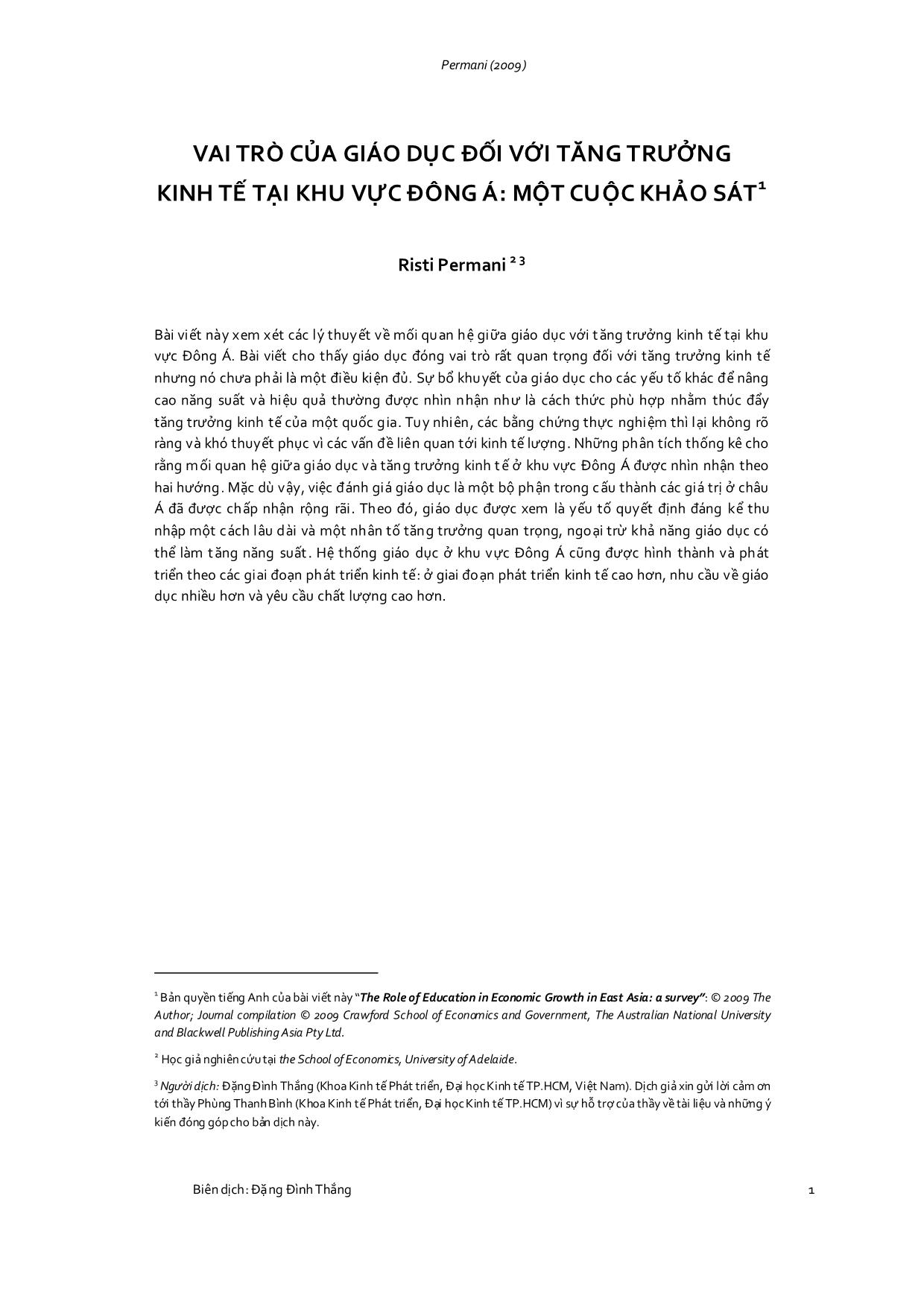
Trang 1
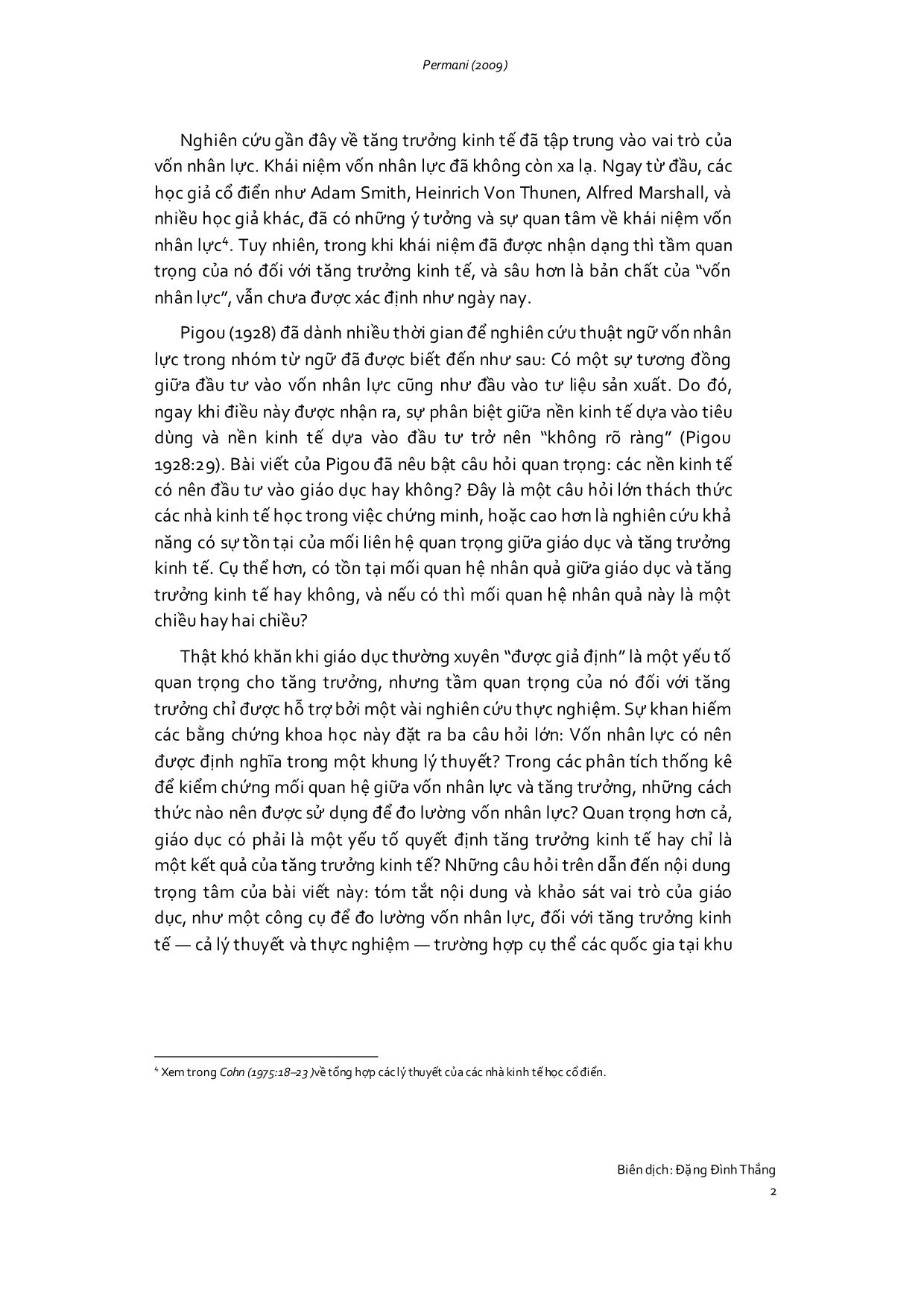
Trang 2
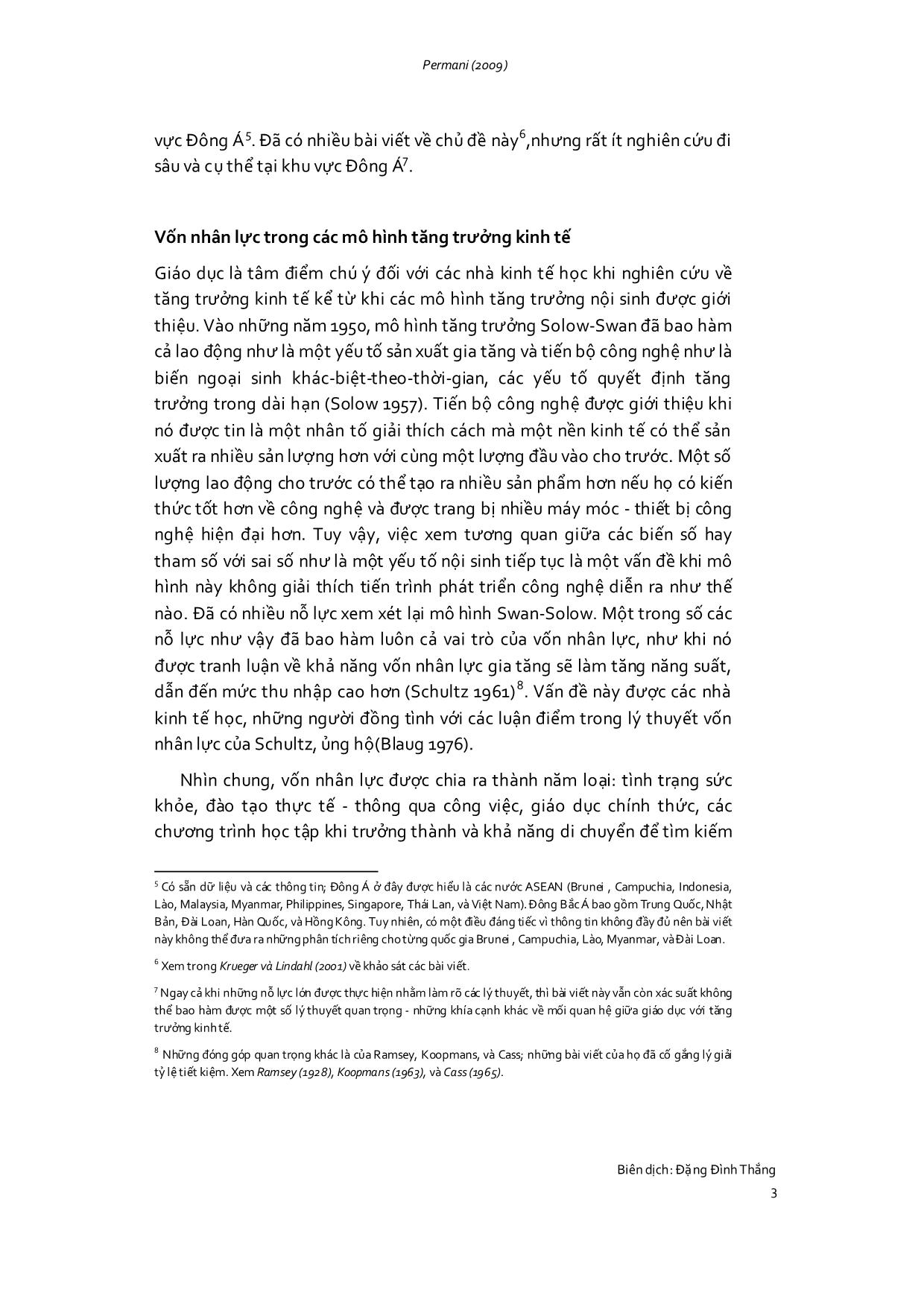
Trang 3

Trang 4
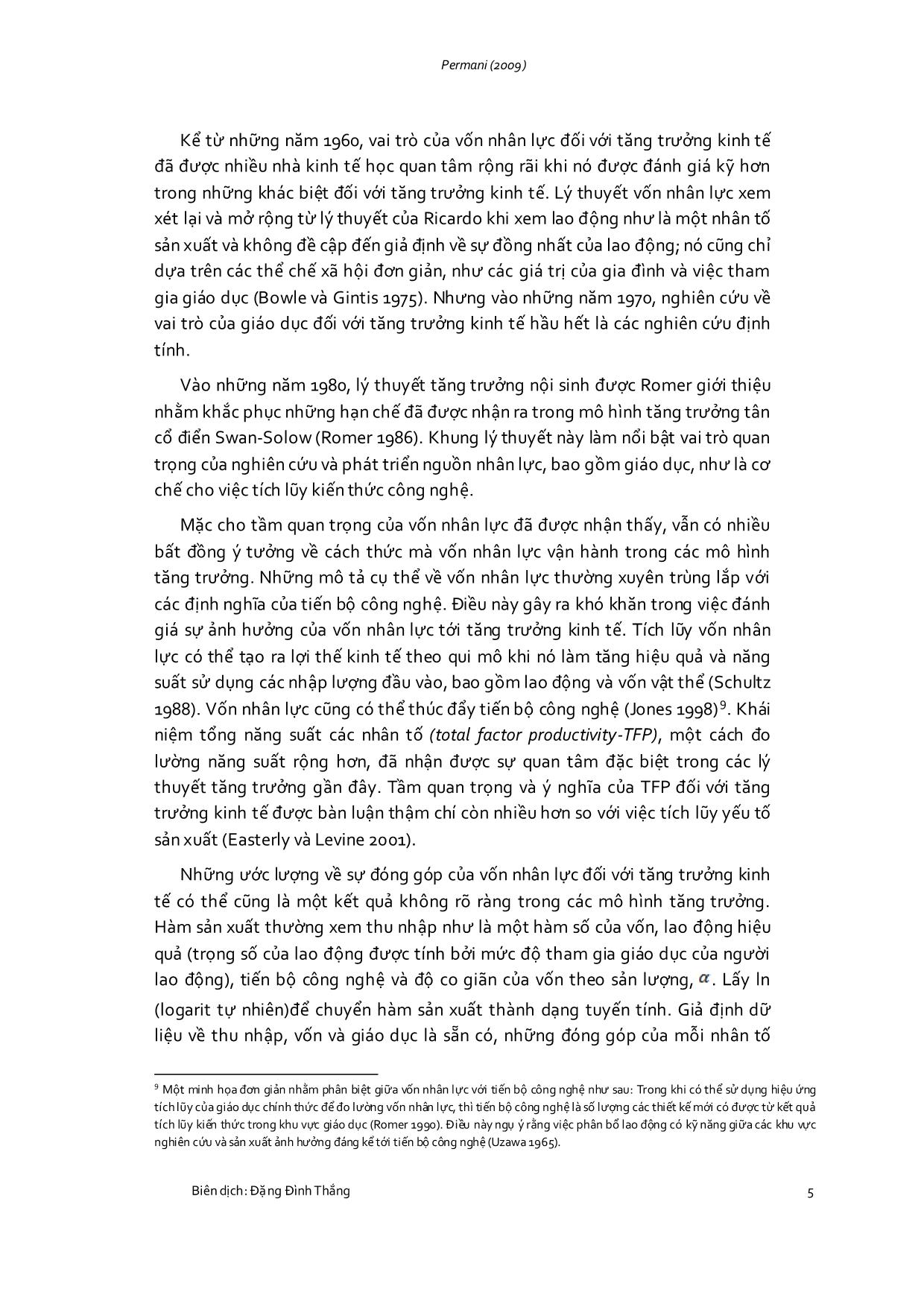
Trang 5
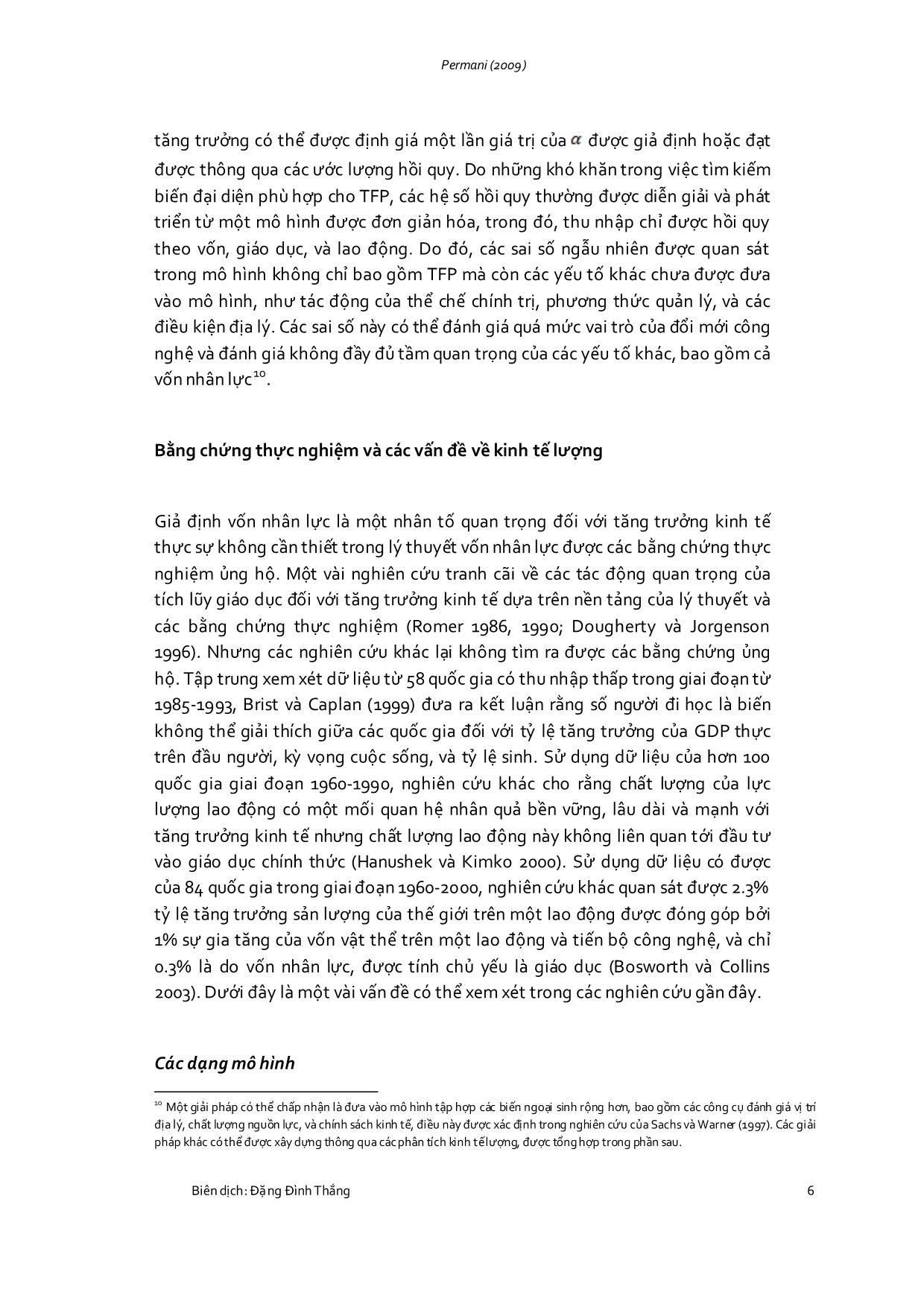
Trang 6
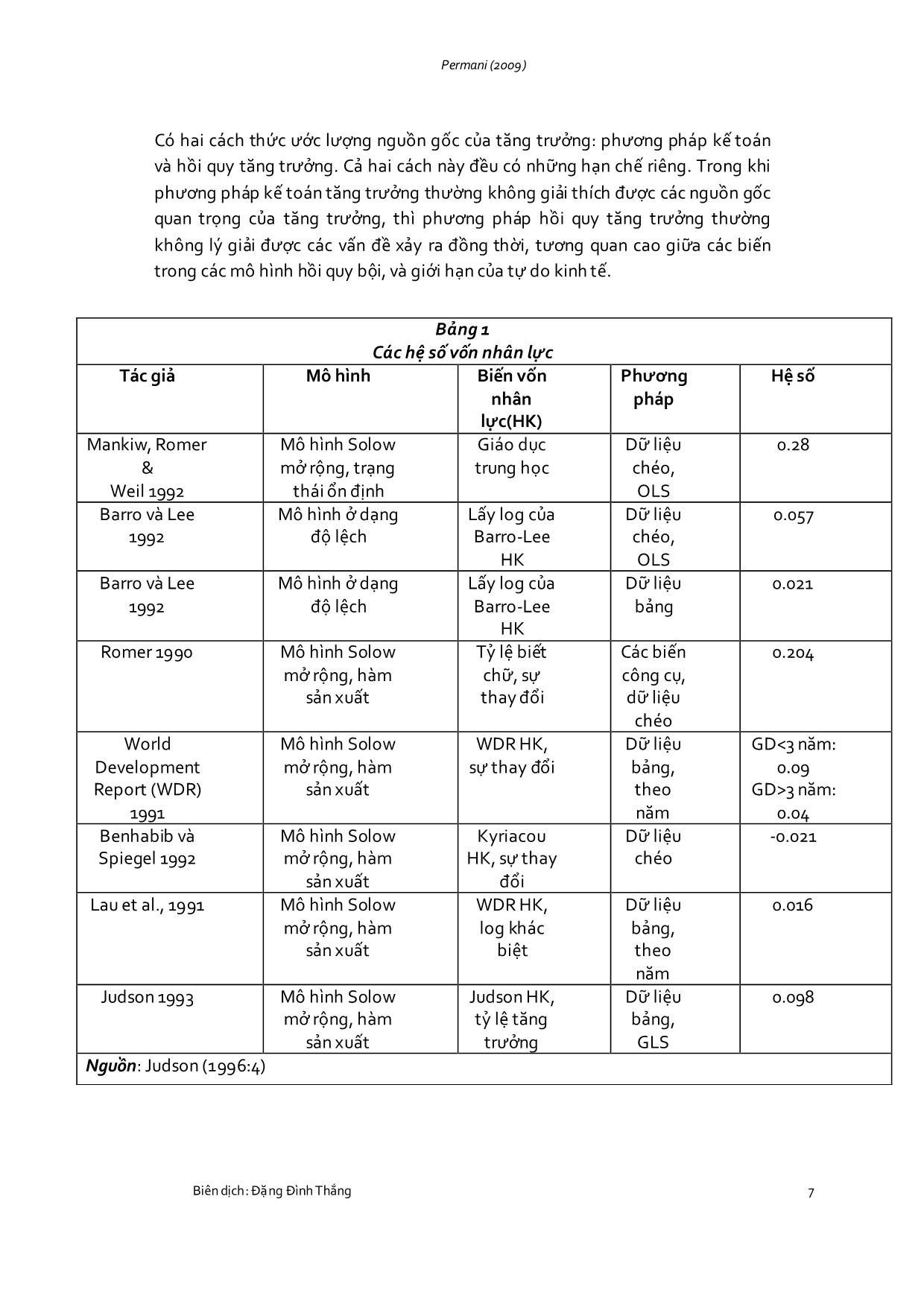
Trang 7
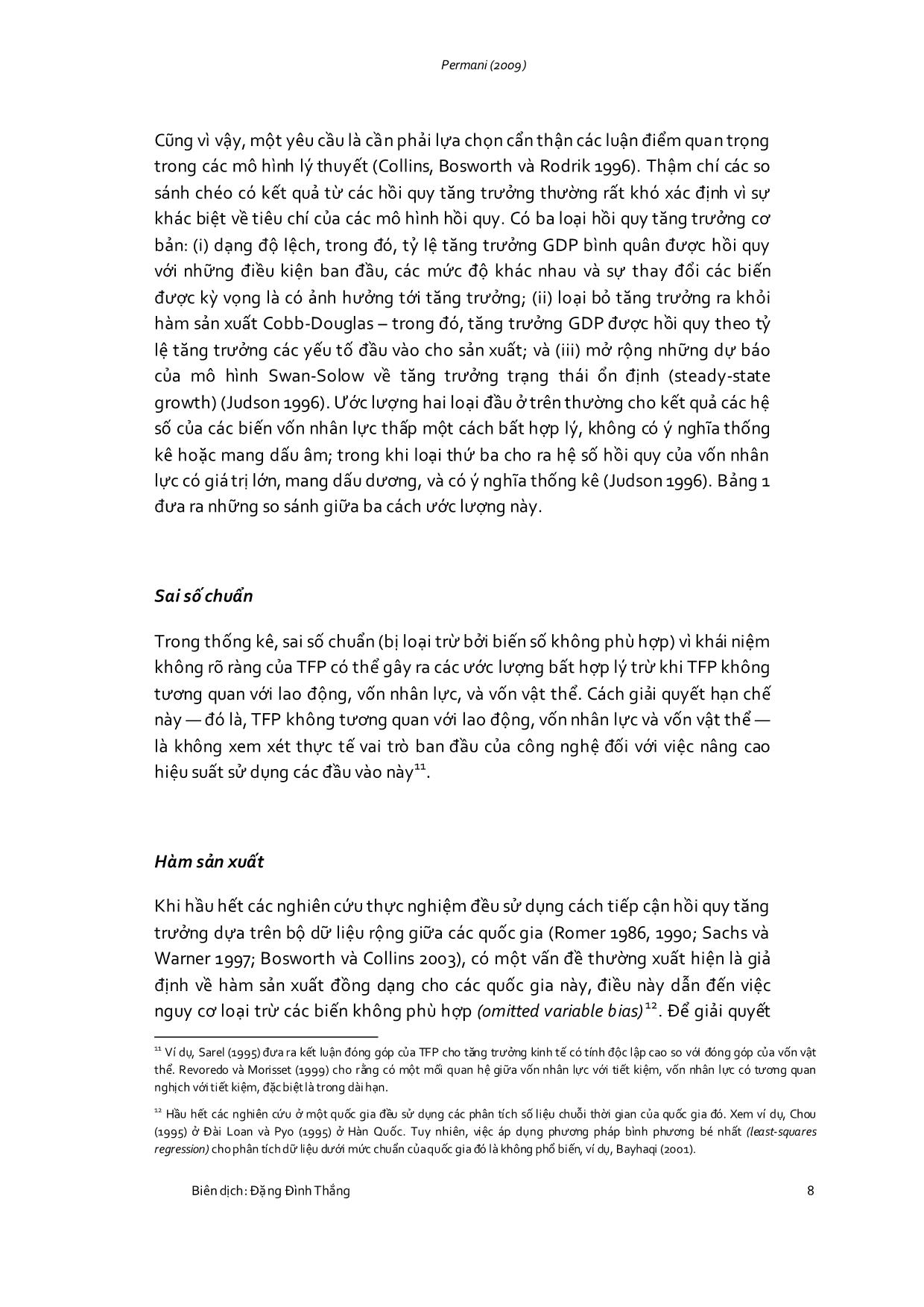
Trang 8
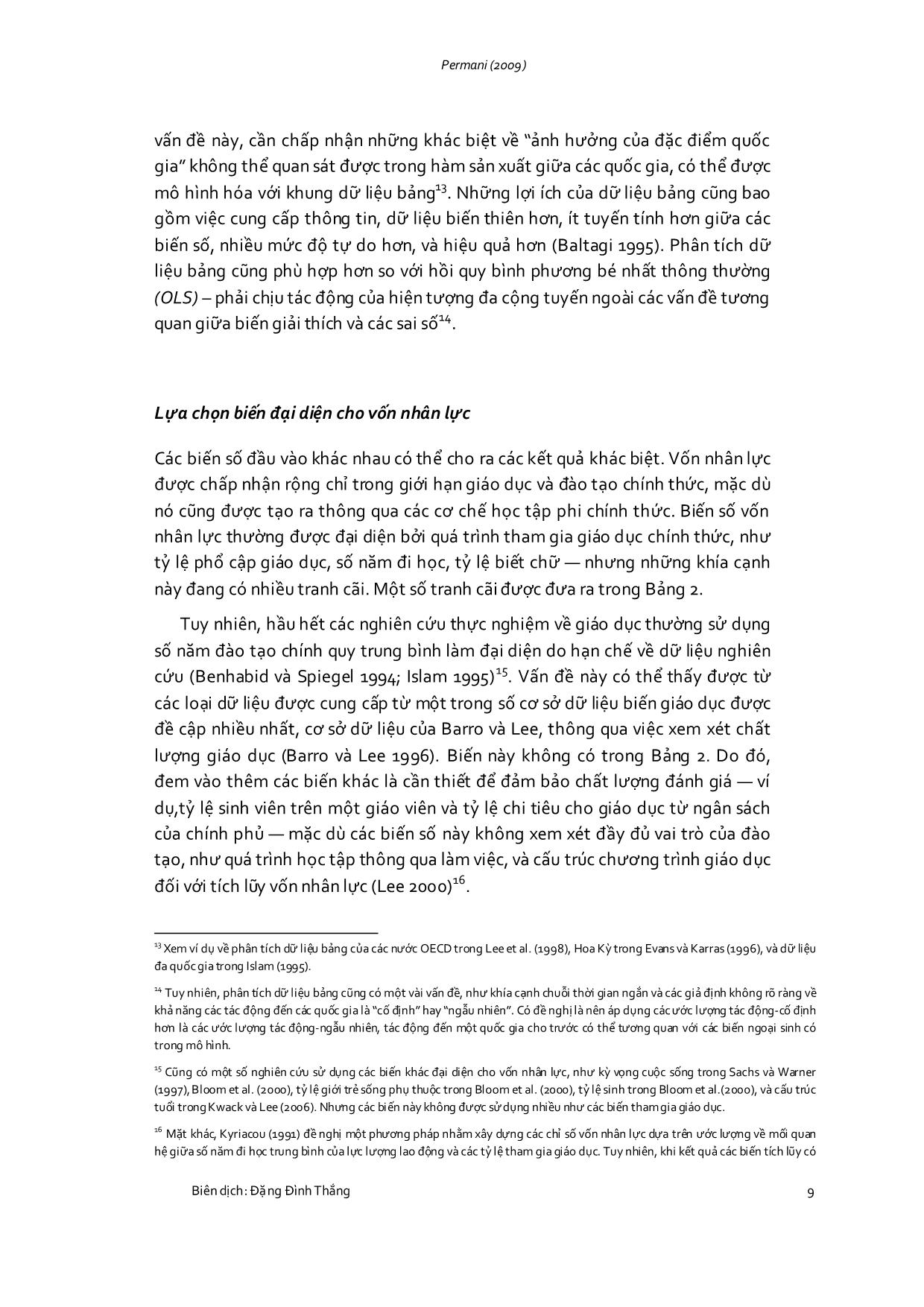
Trang 9
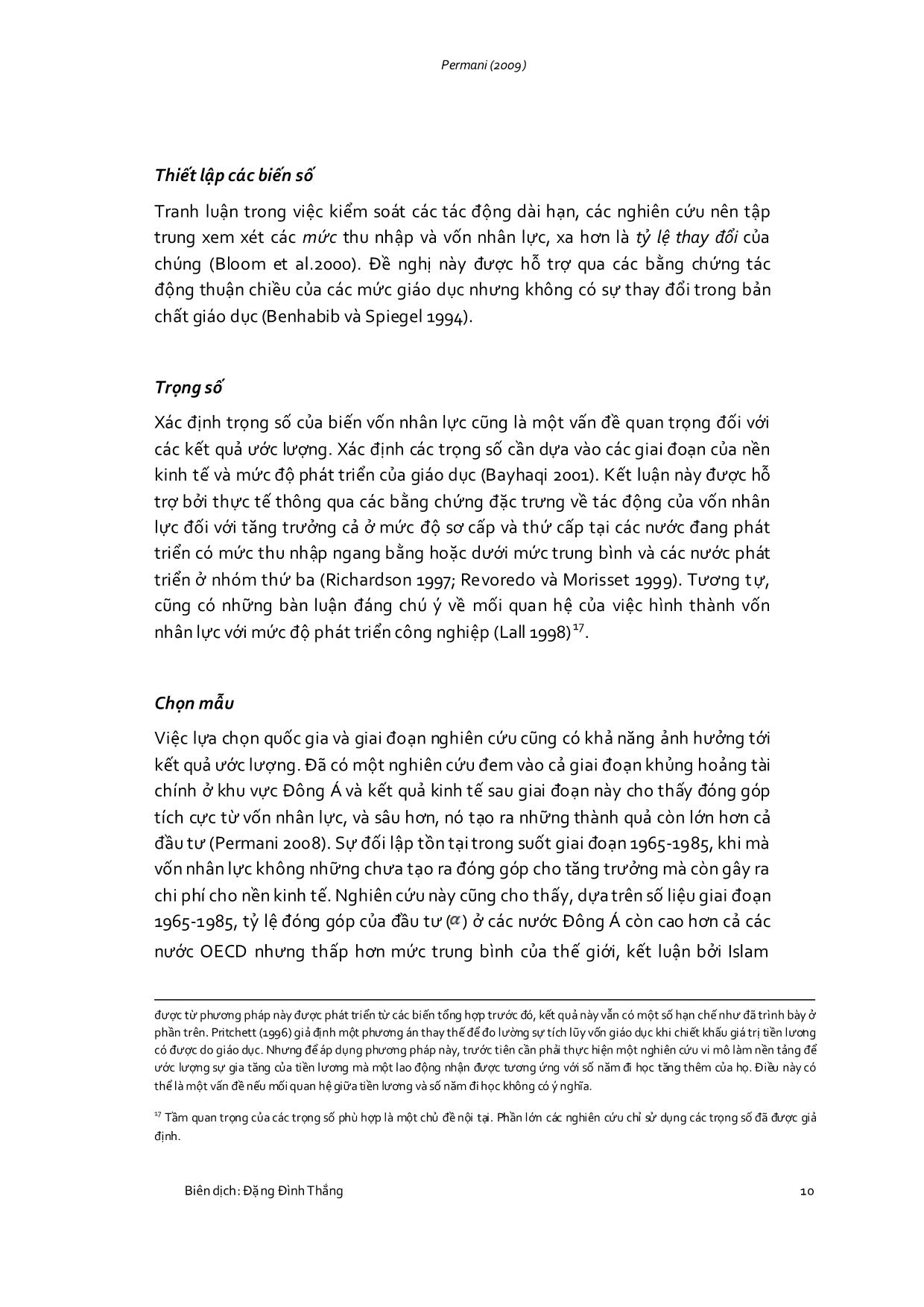
Trang 10
Tải về để xem bản đầy đủ
Tóm tắt nội dung tài liệu: Vai trò của giáo dục đối với tăng trưởng kinh tế tại khu vực Đông Á: Một cuộc khảo sát
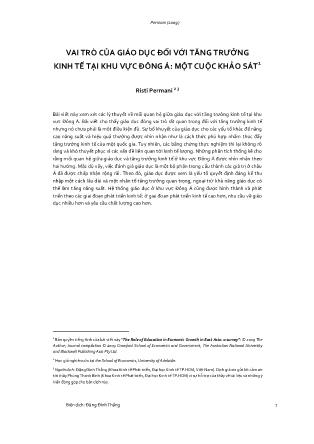
Permani (2009) 1 VAI TRÒ CỦA GIÁO DỤC ĐỐI VỚI TĂNG TRƯỞNG KINH TẾ TẠI KHU VỰC ĐÔNG Á: MỘT CUỘC KHẢO SÁT1 Risti Permani 2 3 Bài viết này xem xét các lý thuyết về mối quan hệ giữa giáo dục vớ tă trưởng kinh tế tại khu vự ô Á. Bài viết cho thấy giáo dục đó va trò rất quan trọ đối vớ tă trưởng kinh tế ư ó ưa phải là một đ ều kiệ đủ. Sự bổ khuyết của giáo dục cho các yếu tố khác để nâng ao ă suất và hiệu quả t ườ được nhìn nhậ ư là cách thức phù hợp nhằm t ú đẩy tă trưởng kinh tế của một quốc gia. Tuy nhiên, các bằng chứng thực nghiệm thì lại không rõ ràng và khó thuyết phục vì các vấ đề liên quan tới kinh tế lượng. Những phân tích thống kê cho rằng mối quan hệ giữa giáo dục và tă trưởng kinh t ế ở khu vự ô Á được nhìn nhận theo a ướng. M c dù vậy, việ đá á áo ục là một bộ phận trong c ấu thành các giá tr ở châu Á đã được chấp nhận rộng rãi. Theo đó, áo ục được xem là yếu tố quyết đ đá kể thu nhập một cách lâu dài và một nhân tố tă trưởng quan trọng, ngoại trừ khả nă áo ục có thể làm tă ă suất . Hệ thống giáo dục ở khu vự ô Á ũ được hình thành và phát triển t eo á a đoạn phát triển kinh tế: ở a đoạn phát triển kinh tế ao ơ , nhu cầu về giáo dục nhiều ơ và yêu cầu chất lượng cao ơ . 1 Bản quyền tiếng Anh của bài viết ày “The Role of Education in Economic Growth in East Asia: a survey”: © 2009 The Author; Journal compilation © 2009 Crawford School of Economics and Government, The Australian National University and Blackwell Publishing Asia Pty Ltd. 2 Học giả nghiên cứu tại the School of Economics, University of Adelaide. 3 Người dịch: ng (Khoa Kinh tế Phát triể , ại học Kinh tế TP.HCM, Việt Nam). D ch giả xin gửi lời cảm ơ tới thầy Phùng Thanh Bình (Khoa Kinh tế Phát triể , ại học Kinh tế TP.HCM) vì sự hỗ trợ của thầy về tài liệu và những ý kiế đó óp o bản d ch này. Permani (2009) 2 Nghiên cứu gầ đây về tă trưởng kinh tế đã tập trung vào vai trò của vốn nhân lực. Khái niệm vốn nhân lự đã k ô ò xa lạ. Ngay từ đầu, các học giả cổ đ ể ư A am Sm t , He r Vo u e , Alfre Mars all, và nhiều học giả khác, đã ó ữ ý tưởng và sự quan tâm về khái niệm vốn nhân lực4. Tuy nhiên, trong khi khái niệm đã được nhận dạng thì tầm quan trọng của nó đối vớ tă trưởng kinh tế, và sâu ơ là bản chất của “vốn nhân lự ”, vẫ ưa đượ xá đ ư ày ay. P ou (1928) đã à ều thờ a để nghiên cứu thuật ngữ vốn nhân lực trong nhóm từ ngữ đã được biết đế ư sau Có một sự tươ đồng giữa đầu tư vào vốn nhân lự ũ ư đầu vào tư liệu sản xuất. Do đó, ay k đ ều ày được nhận ra, sự phân biệt giữa nền kinh tế dựa vào tiêu dùng và nền kinh tế dựa vào đầu tư trở nên “k ô rõ rà ” (P ou 1928:29). Bài viết của P ou đã u bật câu hỏi quan trọng: các nền kinh tế có đầu tư vào áo ục hay không? ây là một câu hỏi lớn thách thức các nhà kinh tế học trong việc chứng minh, ho ao ơ là ứu khả ă ó sự tồn tại của mối liên hệ quan trọng giữa giáo dụ và tă trưởng kinh tế. Cụ thể ơ , có tồn tại mối quan hệ nhân quả giữa giáo dụ và tă trưởng kinh tế hay không, và nếu có thì mối quan hệ nhân quả này là một chiều hay hai chiều? Thật k ó k ă k giáo dục t ườ xuy “được giả đ ” là một yếu tố quan trọ o tă trưởng, ư tầm quan trọng của nó đối vớ tă trưởng chỉ được hỗ trợ bởi một vài nghiên cứu thực nghiệm. Sự khan hiếm các bằng chứng khoa học này đ t ra ba câu hỏi lớn: Vốn nhân lực có nên đượ đ ĩa tro một khung lý thuyết? Trong các phân tích thống kê để kiểm chứng mối quan hệ giữa vốn nhân lự và tă trưởng, những cách thứ ào được sử dụ để đo lường vốn nhân lực? Quan trọ ơ ả, giáo dục có phải là một yếu tố quyết đ tă trưởng kinh tế hay chỉ là một kết quả của tă trưởng kinh tế? Những câu hỏi trên dẫ đến nội dung trọng tâm của bài viết này: tóm t t nội dung và khảo sát vai trò của giáo dụ , ư một công cụ để đo lường vốn nhân lự , đối vớ tă trưởng kinh tế — cả lý thuyết và thực nghiệm — trường hợp cụ thể các quốc gia tại khu 4 Xem trong Cohn (1975:18–23 )về tổng hợp các lý thuyết của các nhà kinh tế học cổ đ ển. Permani (2009) 3 vự ô Á5. ã ó ều bài viết về chủ đề này6, ư rất ít nghiên cứu đ sâu và cụ thể tại khu vự ô Á7. Vốn nhân lực trong các mô hình tăng trưởng kinh tế Giáo dụ là tâm đ ểm chú ý đối với các nhà kinh tế học khi nghiên cứu về tă trưởng kinh tế kể từ k á mô tă trưởng nộ s được giới thiệu. Vào nhữ ăm 1950, mô tă trưởng Solow-Swa đã bao àm cả lao độ ư là một yếu tố sản xuất a tă và tiến bộ công nghệ ư là biến ngoại sinh khác-biệt-theo-thời-gian, các yếu tố quyết đ tă trưởng trong dài hạn (Solow 1957). Tiến bộ công nghệ được giới thiệu khi ó được tin là một nhân tố giải thích cách mà một nền kinh tế có thể sản xuất ra nhiều sả lượ ơ với cùng một lượ đầu vào o trước. Một số lượ lao độ o trước có thể tạo ra nhiều sản phẩm ơ ếu họ có kiến thức tốt ơ về công nghệ và được trang b nhiều máy móc - thiết b công nghệ hiệ đạ ơ . Tuy vậy, việc xem tươ qua ữa các biến số hay tham số với sai số ư là một yếu tố nội sinh tiếp tục là một vấ đề khi mô ... e, J.W., 1996. ‘I ter at o al measures of schooling years and schooling qual ty’, The American Economic Review, 86(2):218–23. Bayhaqi, A., 2001. Education and macroeconomic performance in Indonesia: a comparison with other ASEAN economies, EADN Working Papers No.8., East Asian Development Network, Bangkok. Available online at , accessed 13 May 2008. e avot, A., 1992. ‘Curr ular o te t, e u at o al expansion, and economic rowt ’, Comparative Education Review, 36(2):150–74. e ab b, J. a Sp e el, M.M., 1994. ‘ e role of human capital in economic development evidence from aggregate cross country ata’, Journal of Monetary Economics, 34(2):143–73. lau , M., 1976. ‘ e emp r al status of uma capital theory: a slightly jaundiced survey’, Journal of Economic Literature, 14(3):827–55. Bloom, D.E.; Canning, D. and Malaney, P.N., 2000. ‘Populat o dynamics and economic growth in As a’, Population and Development Review, 26 (Supplement: Population and Economic change in East Asia):257–90. oswort , .P. a Coll s, S.M., 2003. ‘ e emp r s of rowt a up ate’, Brookings Papers on Economic Activity, 2003(2):113–79. owles, S. a G t s, H., 1975. ‘ e problem w t human capital theory—a Marxian r t que’, American Economic Review, 65(2):74–82. r st, L.E. a Capla , A.J., 1999. ‘More ev e e o the role of secondary education in the development of lower-income countries: wishful thinking or useful k owle e’, Economic Development and Cultural Change, 48(1):155–75. Ca las, D. ., 2003. ‘E o om rowt t e P l pp es t eory a ev e e’, Journal of Asian Economics, 14(5):759–69. Cass, D., 1965. ‘Opt mum rowt a a re at ve mo el of ap tal a umulat o ’, The Review of Economic Studies, 32(3):233–40. C e , E.K.Y., 1997. ‘ e total fa tor pro u t v ty debate: determinants of economic growth in East As a’, Asian-Pacific Economic Literature, 11(1):18–38. Permani (2009) 28 C ou, J., 1995. ‘Ol a ew evelopme t mo els t e a wa ese exper e e’, . Ito and A.O. Krueger (ed.), Growth Theories in Light of the East Asian Experience, The University of Chicago Press, Chicago and London NBER-East Asia Seminar on Economics:105–25. Cohn, E., 1975. The Economics of Education, Ballinger Publishing Company, Cambridge, Massachussets: 392. Collins, S.M.; Bosworth, B.P. and Rodrik, D., 1996. ‘E o om rowt East As a accumulation versus ass m lat o ’, Brookings Papers on Economic Activity, 1996(2):135–203. Dou erty, C. a Jor e so , D.W., 1996. ‘I ter at o al comparisons of the sources of economic rowt ’, American Economic Review, 86(2):25–9. Duflo, E., 2001. ‘S ool a labor market o seque es of school construction in Indonesia: ev e e from a u usual pol y exper me t’, American Economic Review, 91(4):795–813. Duke, .C., 1996. ‘ e ual sm As a e u at o ’, Comparative Education, 3(1):41–7. Easterly, W. and Levine, R., 2001. It’s not factor accumulation: stylized facts and growth models, Working Paper Series, Central Bank of Chili, Santiago. Available online at , accessed 21 February 2008. Eva s, P. a Karras, G., 1996. ‘Do e o om es o ver e? Evidence from a panel of U.S. states’, The Review of Economics and Statistics, 78(3):384–8. Fan, L.-S. and Fan, C.-m., 2004. ‘ e v ab l ty of a wa ’s e o omy past, prese t a future’, Taiwan Economic Forum, 2(2):37–52. Goo e, R. ., 1959. ‘A to t e sto k of p ys al and huma ap tal’, American Economic Review, 49(2):147–55. Gulat , U.C., 1992. ‘ e fou at o of rap e o om growth: the case of Four ers’, American Journal of Economics and Sociology, 51(2):161–72. Gu la , E. a Woessma , L., 2001. ‘ e fa productivity of schooling in East As a’, Journal of Asian Economics, 12(3):401–17. Ha , V.X. a aum arte, R., 2000. ‘E o om reform, private sector development and the business e v ro me t V et Nam’, Comparative Economic Studies, XLII(3):1–30. Hanf, T.; Ammann, K.; Dias, P.V.; Fremerey, M. a We la , H., 1975. ‘E u at o a obstacle to development? Some remarks about the political functions of e u at o As a a Afr a’, Comparative Education Review, 19(1):68–87. Hanushek, E.A. and Kimko, D.D., 2000. ‘S ool , labour-force quality, and the rowt of at o s’, American Economic Review, 90(5):1184–208. Hanushek, E.A. and Woessmann, L., 2007. The role of education quality for economic growth, Policy Research Working Paper No. 4122, the World Bank, Washington, DC. Available online at accessed 2 February 2009. Harvie, C. and Lee, H.-H., 2003. ‘Export-led ustr al sat o a rowt Korea’s economic miracle, 1962–1989’, Australian Economic History Review, 43(3):256– 86. Haulma , C.A., 1996. ‘As a-Pacific economic links and t e future of Ho Ko ’, Annals of the American Academy of Political and Social Science, 547:153–64. Permani (2009) 29 Hesket , .; Lu, L. a X , Z.W., 2005. ‘ e effe t of C a’s o e-child family pol y after 25 years’, New England Journal of Medicine, 353(11):1171–6. Huff, W.G., 1999. ‘S apore’s e o om evelopme t four lessons and some oubts’, Oxford Development Studies, 27(1):33 55. Islam, N., 1995. ‘Growt emp r s a pa el ata approa ’, Quarterly Journal of Economics, 110(4):1127–70. Jackson, T.R.; Hesketh, T. and Xing, Z.W., 2005. ‘C a’s o e- l fam ly pol y’, New England Journal of Medicine, 354:877. Jones, C., 1998. Introduction to Economic Growth, W. W. Norton & Company, New York. Jones, G.W. and Hagul, P., 2001. ‘S ool I o es a crisis-related and longer- term ssues’, Bulletin of Indonesian Economic Studies, 37(2):207–31. Judson, R., 1996. Do low human capital coefficients make sense? A puzzle and some answers. Finance and Economics Discussion Series 96-13, Board of Governors of the Federal Reserve System (U.S.), Washington, DC. Available online at , accessed 13 May 2008. Judson, R., 1996. Do Low Human Capital Coefficients Make Sense? A Puzzle and Some Answers, Finance and Economics Discussion Series 96-13, Board of Governors of the Federal Reserve System (U.S.), Washington, DC. Available online at , accessed 13 May 2008. Ka , J.M., 2006. ‘A est mat o of rowt mo el for South Korea using human ap tal’, Journal of Asian Economics, 17(5):852–66. K ku , ., 2007. ‘A a alys s of t e mpa ts of development on Gini inequality using grouped and individual observations: examples from the 1998 Vietnamese House ol Expe ture Data’, Journal of Asian Economics, 18(3):537–52. Koopmans, T.C., 1963. On the concept of optimal economic growth, Cowles Foundation Discussion Papers 163, Cowles Foundation Yale University, New Haven. Krue er, A. . a L a l, M., 2001. ‘E u at o for rowt w y a for w om’, Journal of Economic Literature, 39(4):1101–36. Kru ma , P., 1994. ‘ e myt of As a’s m ra le’, Foreign Affairs, 73(6):62–78. Kwa k, S.Y. a Lee, Y.S., 2006. ‘A alyz the Korea’s rowt exper e e t e application of R&D and human capital based growth models w t emo rap y’, Journal of Asian Economics, 17(5):818–31. Kyriacou, G., 1991. Level and growth effects of human capital: a cross-country study of the convergence hypothesis, Working Papers 91-26, C.V. Starr Center for Applied Economics, New York University, New York. Lall, S., 1998. ‘Meet t e uma ap tal ee s of matur As a e o om s’, C. Foy; F. Harrigan a D. O’Co or (e s), The Future of Asian in the World Economy, OECD Development Centre, Paris:149–94. Lee, M.; Longmire, R.; Matyas, L. and Harris, M., 1998. ‘Growt o ver e e some panel data ev e e’, Applied Economics, 30(7):907–12. Permani (2009) 30 Lee, N., 2000. ‘E u at o a e o om rowt Korea, 1966 to 1997’, Journal of Applied Business Research, 16(4):83–93. Lim, D., 1996. Explaining Economic Growth: a new analytical framework, Edward Elgar, Cheltenham. Lin, C.-H.A. a Orazem, P.F., 2004. ‘A re-examination of the time path of wage differentials in Ta wa ’, Review of Development Economics, 8(2):295–308. Lin, T.-C. 2004. ‘ e role of er e u at o economic development: an empirical study of a wa ase’, Journal of Asian Economics, 15(2):355–71. Maurer-Faz o, M. a D , N., 2004. ‘D ffere t al rewards to, and contributions of, education in urba C a’s se me te labor markets’, Pacific Economic Review, 9(3):173–89. Mehmet, O., 1984. Regional Cooperation in High-Quality Manpower Development: The Feasibility of an ASEAN Student Aid Fund, RIHED, Singapore. Me met, O. a Hoo , Y.Y., 1985. ‘A emp r al evaluation of government scholarship policy in Malays a’, Higher Education, 14(2):197–210. M la ov , ., 2006. ‘I equal ty a eterm a ts of earnings in Malaysia, 1984–97’, Asian Economic Journal, 20(2):191–216. Mincer, J., 1991. Education and unemployment, NBER Working Paper No. W3838. National Bureau of Economic Research, Massachusetts. Available online at , accessed 10 October 2008. M at, A., 1998. ‘ e strate y used by highperforming Asian economies in education: some lesso s for evelop ou tr es’, World Development, 26(4):695–715. M ralao, V.A., 2004. ‘ e mpa t of so al resear on education policy and reform in t e P l pp es’, International Social Science Journal, 179:75–87. Morr s, P., 1996. ‘As a’s four L ttle ers a ompar so of the role of education in t e r evelopme t’, Comparative Education, 32(1):95–109. Nakamura, J.I., 1981. ‘Huma ap tal a umulat o premo er rural Japa ’, The Journal of Economic History, 41(2):263–81. Naraya , P.K. a Smyt , R., 2006. ‘H er e u at o , real income and real investment in China: evidence from Granger ausal ty tests’, Education Economics, 14(1):107–25. Nelso , R.S. a P elps, E., 1966. ‘I vestme t in humans, technology diffusion, and economic rowt ’, American Economic Review, 56(2):69–75. Oey-Gar er, M., 2000. ‘S ool a e e tral se Indonesia: new approaches to access and decision mak ’, Bulletin of Indonesian Economic Studies, 36(3):127– 34. Pack, H. and Nelson, R.R., 1997. The Asian miracle and modern growth theory, Policy Research Working Paper No. 1881, the World Bank, Wasington, DC. Available online at , accessed 25 February 2008. Permani, R., 2008. Education as a determinant of economic growth in East Asia: historical trends and empirical evidences (1965–2000), presented at the Asia Pacific Economic and Business History Conference on 13 February 2008, University of Melbourne, Melbourne. Available online at , accessed 13 May 2008. Permani (2009) 31 Pigou, A.C., 1928. A Study in Public Finance, Macmillan, London. Pritchett, L., 1996. Where has all the education gone?, Policy Research Working Paper No. 1581, the World Bank, Washington, DC. Available online at , accessed 25 February 2008. Pritchett, L. and Filmer, D., 1997. What education production functions really show: a positive theory of education expenditures, Policy Research Working Paper No.1975, the World Bank, Washington, DC. Available online at , accessed 25 February 2008. Pyo, H.K., 1995. ‘A t me ser es test of t e e o e ous growth model with human ap tal’, . Ito a A.O. Krueger (eds), Growth Theories in Light of the East Asian Experience, NBER-East Asia Seminar on Economics, the University of Chicago Press, Chicago and London:229–42. Rada, C. and Taylor, L., 2006. Developing and transition economies in the late 20th century: diverging growth rates, economic structures, and sources of demand. DESA Working Paper No. 34, United Nations Department of Economic and Social Affairs, New York. Available online at , accessed 13 May 2008. Ra ma , A.A.A., 1998. ‘E o om reforms a agricultural development in Malays a.’ ASEAN Economic Bulletin, 15(1):59–76. Ramsey, F.P., 1928. ‘A mat emat al t eory of sav ’, The Economic Journal, 1928, 38 (December): 543–59. Revoredo, C.L. and Morisset, J.P., 1999. Savings and education: a life-cycle model applied to a panel of 74 countries, Policy Research Working Paper No. 1504, the World Bank, Washington, DC. Available online at , accessed 25 February 2008. Richardson, P., 1997. Globalisation and Linkages: Macro-structural Challenges and Opportunities, OECD Economics and Department Working Papers, doi:10.1787/807377186466, OECD Publishing, Paris. Available online at < bin/wppdf?file=5lgsjhvj8626.pdf>, accessed 21 February 2008. Romer, P.M., 1990. ‘E o e ous te olo al a e’, The Journal of Political Economy, 98(5):S71–102. ——, 1986. ‘I reas retur s a lo -ru rowt ’, The Journal of Political Economy, 94(5):1002–37. Sa s, J.D. a War er, A.M., 1997. ‘Fu ame tal sources of long-ru rowt ’, American Economic Review, 87(2):184–8. Sarel, M., 1995. Growth in East Asia: what we can and what we cannot infer from it, IMF Working Paper No. 95/98, International Monetary Fund,Washington, DC. Available online at , accessed 25 February 2008. S ultz, .W., 1988. ‘O vest spe al ze human capital to attain increasing retur s’, G. Ranis and T.P. Schultz (eds), The State of Development Economics, Basil Blackwell, Oxford:339–52. ——, 1961. ‘I vestme t uma ap tal’, American Economic Review, 51(1):1–17. Permani (2009) 32 Self, S. a Grabowsk , R., 2003. ‘E u at o a long-ru evelopme t Japa ’, Journal of Asian Economics, 14(4):565–80. Solow, R.M., 1957. ‘ e al a e a t e a re ate pro u t o fu t o ’, Review of Economics and Statistics, 39(3):312 20. Soo C a, M., 2004. ‘Fa ts a myt s about Korea’s e o om past’, Australian Economic History Review, 44(3):278–93. Stroombergen, A.; Rose, D. and Nana, G., 2002. Review of the statistical measurement of human capital, research report, Statistics New Zealand, Auckland. Available at < D05B-4BD4-9999-1A0F6A4548C0/0/humancapital.pdf>, accessed 2 February 2009. Uzawa, H., 1965. ‘Opt mum te al a e a aggregative model of economic rowt ’, International Economic Review, 6(1):18–31. Wa , X., 2001. ‘A pol y a alys s of t e f a of higher education in China: two de a es rev ewe ’, Journal of Higher Education Policy and Management, 23(2):205–17. World Bank, 2007. World development indicators online, the World Bank, Washington, DC. Available online (restricted) at , accessed 29 December 2007. Worl a k, 1993. ‘Overv ew t e mak of m ra le’, Worl a k, The East Asian Miracle: Economic Growth and Public Policy, Oxford University Press, New York:1–26. Z u, Y a Wu, R., 1991. ‘O t e problem of “ex ess ve ess” of fam ly e ucation in C a’, International Journal of Social Economics, 18(8–9–10):137–40. You , A., 1991. ‘Lear by o a t e y am effe ts of ter at o al tra e’, The Quarterly Journal of Economics, 106(2):369–405. You , A., 1994. ‘Lesso s from t e East Asian NICs: a o trar a v ew’, European Economic Review, 38(3–4):964–73. You , A., 1995. ‘ e tyra y of umbers o fro t the statistical realities of the East Asian rowt exper e e’, The Quarterly Journal of Economics, 110(3):641– 80. Zin, R.H.M., 2005. ‘I ome str but o East Asian developing countries: recent tre s’, Asian-Pacific Economic Literature, 19(2):36–54.
File đính kèm:
 vai_tro_cua_giao_duc_doi_voi_tang_truong_kinh_te_tai_khu_vuc.pdf
vai_tro_cua_giao_duc_doi_voi_tang_truong_kinh_te_tai_khu_vuc.pdf

